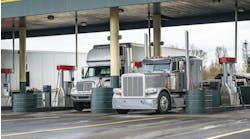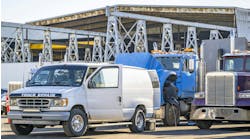Last week, Tesla delivered its first battery-electric heavy-duty vehicle, the Semi, to PepsiCo. The long-awaited delivery (Tesla CEO Elon Musk initially promised delivery in 2019) provided a fair amount of information while at the same time leaving lots of unanswered questions.
My takeaways from the event are that the truck is real. I saw 10 of them ready to go into service—and the production line on which the initial units are being manufactured was full of more Semis being built.
See also: A salute to truck drivers
So, what are my impressions now? I would describe the Semi as elegantly simple, but I have said that many times about electric trucks in general. But seeing them being built, it’s obvious, as there is just “less stuff” on an electric truck than on a diesel one. I've spent the bulk of my career in truck manufacturing, and there were more people working on engine subassemblies in truck plants than are needed to produce the Semi. I think there were nine production stations the trucks went through from beginning to final assembly.
And the components that are on the truck all seem smaller, designed specifically for a long regional haul on highway tractor. The instrument panel, for example, is significantly smaller than traditional ones in heavy-duty trucks. The batteries were smaller than I thought (not sure yet exactly the capacity as it was not announced), and the frame was simpler.
I wish there had been more information on the weight of the truck as well as what variations would be available. For example, the trucks I saw at the event had dual wheels and tires. Will there be a wide-base tire option? What about a 4x2 or an extended cab for a sleeper? I expect fleets to ask for these very soon.
See also: PepsiCo becomes first fleet to procure Tesla Semis
And there was no information on the total cost of operation other than comments about how fleets would love them. At some point, fleets are going to want to know—and will need to know—what it costs to not only buy a Semi but also to operate it. Total cost of ownership, including the cost of the charging infrastructure, is crucial to fleets.
However, Musk shared some details from the recent 500-mile drive of an 81,000-lb. Semi on a single charge. From the details shared, this was no inconsequential run downhill with the wind behind you. It was a rigorous duty cycle with a full legal load and going up and over a 4,100-ft. peak at Grapevine. This was clearly the most important news we learned on Dec. 1.
In summary, I am glad I was at the event. The truck looks good, and Tesla is delivering on their promises, but there are still a fair number of questions that need to be answered. And based on the work NACFE does and what we learned from Run on Less, both Regional and Electric, the recent 500-mile trip the Semi made was a demanding one that provides a new industry benchmark for electrifying freight movements.
Michael Roeth has worked in the commercial vehicle industry for nearly 30 years, most recently as executive director of the North American Council for Freight Efficiency (NACFE). He serves on the second National Academy of Sciences Committee on Technologies and Approaches for Reducing the Fuel Consumption of Medium and Heavy-Duty Vehicles and has held various positions in engineering, quality, sales, and plant management with Navistar and Behr/Cummins.





